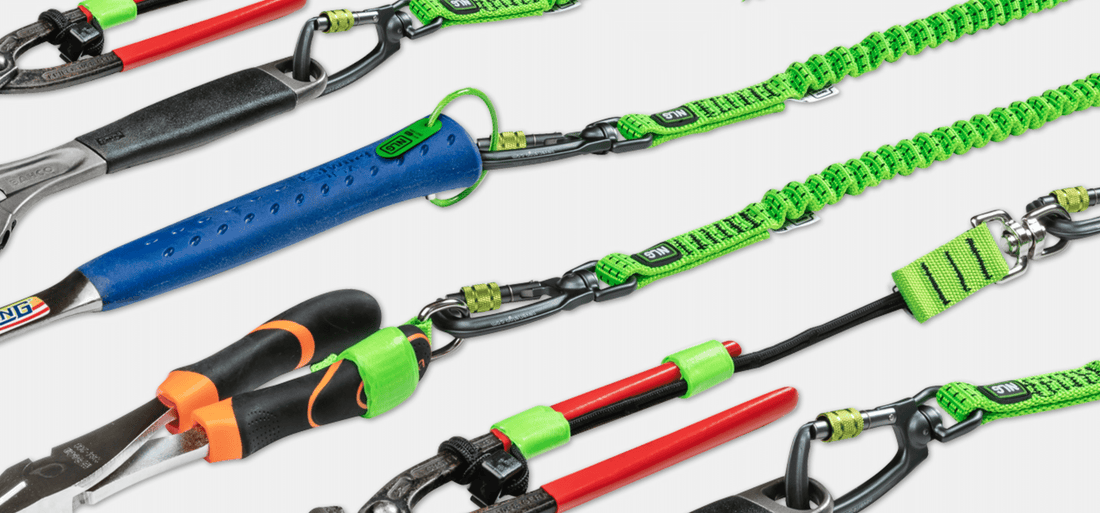European law states that a tool lanyard must at least have a CE marking. CE stands for "Conformité Européenne", which indicates to the manufacturer that the product meets the minimum EU requirements in the field of safety, health and the environment. These requirements are described in the CE certification system, EU standards and legislation.
What are the CE requirements and how does the CE certification system work?
The exact requirements for CE certification depend on the category the product falls under. The process consists of 6 steps, depending on the CE category, this is a process that the manufacturer goes through independently or is assessed by a certification body.
Step 1: Identify the applicable directive(s) and EN standards, possibly together with a certification body.
Step 2: Check product-specific requirements or legal requirements from regulations.
Step 3: Determine whether independent assessment by, for example, Tüv or notified body is necessary.
Step 4: Test the product and check compliance.
Step 5: Prepare and keep available the required technical documentation together with procedures regarding the production and consistency of the product.
Step 6: Draw up the declaration of conformity and apply CE marking.
If we look at PPE categories, various tests and assessment by a certification body will be mandatory for the CE marking, for example, a fall harness. In this way, the certification body, also known as a notified body, guarantees that the product complies with the applicable standard both theoretically and practically.
However, if we look at the category that belongs to Tool lanyards, the independent assessment by a notified body is not necessary. The manufacturer therefore determines whether the product meets the requirements. This is often a theoretical approach without a load test or breaking test.
But why is the CE marking of your tool lanyards so important? And is CE marking sufficient?
Let us explain:
Independently tested Tool lanyards, you can rely on them!
If you use resources to keep people safe, you must be able to rely on them. At ZeroDrops, we believe that a CE marking alone is insufficient, this only confirms theoretical conformity.
A tool tethering system must be well designed and suitable for securing your tools against a fall. There is no point in using a tool lanyard that breaks when the tool is actually dropped. That is why the products on our website are not only CE marked, but have also been independently tested.
In addition to the legally required CE type approval, NLG tool cords are independently tested by a UKAS accredited testing laboratory (comparable to Tüv). By choosing tool cords from NLG, you invest in materials that have been thoroughly tested.
Quality vs. price
With budgets under pressure, we know you are looking for the most cost-effective tool tethering system. But of course it is not without reason that people say "Cheap is expensive". Buying cheap tool lanyards and tool tethering systems is a bad economy and can put people in danger.
Cheap, wrong savings... Why?
Cheaper products are usually not as robust and have not undergone the same rigorous testing. This in turn means that they won't last as long and you have no guarantees that they will do what they're supposed to do.
Using cheap tool cords and lanyards without CE marking can give your team a false sense of security. It can make them think they are protected when they are not. But isn't your commitment to a safe workplace greater than that?
We have already seen many "China Export Tool lanyards that fail. Cheap tool cords, often with a false CE marking. If such a tool lanyard fails, it can have serious consequences.
Compliance with NLG products
The NLG tool tether products comply with the PPE Regulation (EU) 2016/425 standard.
The tool cords and tethering materials are subject to strict quality controls during production. Every product must be the same as the products tested by the CE certification institute.
The independent tests are carried out by the test laboratory in accordance with the EN 364: 1992 standard.
An EU declaration of conformity is drawn up if the PPE meets all required measures.
What is quite unique for tool lanyards is that the NLG products are also subjected to a tensile test to test the strength of the materials. A dynamic drop test is performed with 2x the maximum load. Lifting bags and storage equipment are subjected to static strength tests with 5x the permitted weight.
This way you can be confident that all your fall prevention equipment is fit for purpose and has an extra safety factor built in to provide adequate security.
Investing in CE and EN364 certified tool lanyards and tethering systems shows that you value safety. This way you can easily prevent accidents and damage from falling equipment!
In addition to CE, the Never Let Go range also meets the strict American ANSI 12-2018 standard, read more about it in our blog .




